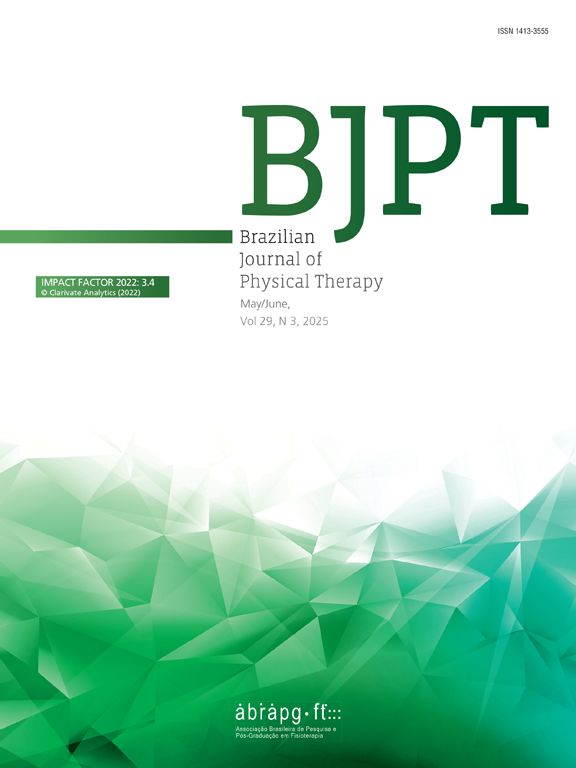18
Measurement properties of upper extremity physical performance tests in athletes: a systematic reviewGermanna Medeiros Barbosa, Letícia Bojikian Calixtre, Hilmaynne Renaly Fonseca Fialho, Francisco Locks, Danilo Harudy Kamonseki
Braz J Phys Ther. 2024;28:100575
18
Highlights
- •
The closed kinetic chain upper extremity stability test (CKCUEST) and the seated Single-Arm/ unilateral seated shot-put test showed adequate reliability.
- •
The seated medicine ball throw is valid to evaluate upper body power.
- •
Other upper extremity physical performance tests should be used with caution due to low quality of evidence or suboptimal measurement properties.
7
Quantity and quality are increasing but there's room for improvement: A scoping review of physical activity intervention trialsMarina B Pinheiro, Ana Helena S Reis, Jennifer N Baldwin, Anne M Moseley, Vishwesh Bapat, Courtney S Chan, Wing S. Kwok, Catherine Sherrington
Braz J Phys Ther. 2024;28:101051
7
Highlights
- •
There are 1779 physical activity trials in the physiotherapy evidence database (PEDro).
- •
The mean (SD) PEDro score was 5.3 (1.5) points out of 10, reflecting ‘fair to poor’ quality.
- •
Journal impact factor is weakly correlated with trial quality (0.21, p < 0.001).
- •
We make five recommendations to improve future trial quality.
7
Normal values for maximal respiratory pressures in children and adolescents: A systematic review with meta-analysisNicole Pradi, Danielle Soares Rocha Vieira, Olívia Ramalho, Ítalo Ribeiro Lemes, Emanuella Cristina Cordeiro, Maiqueli Arpini, Erik Hulzebos, Fernanda Lanza, Dayane Montemezzo
Braz J Phys Ther. 2024;28:100587
7
Highlights
- •
MRP values increased with increasing age.
- •
MEP values, both for girls and boys, were higher than the MIP values for all ages.
- •
Boys had higher MIP and MEP values than girls, regardless of age group.
- •
Large 95% CI values were observed for MIP and MEP, mainly for the 12–19 age group.
- •
For clinical practice, the nationality of the study should be considered.
6
What are participant beliefs regarding physical therapy led treatment? A qualitative study of people living with femoroacetabular impingement syndromeEmily Bell, Andrea Mosler, Christian Barton, Denise Jones, Joshua Heerey, Richard Johnston, Sally Coburn, Joanne Kemp
Braz J Phys Ther. 2024;28:101077
6
Highlights
- •
People with femoroacetabular impingement (FAI) syndrome believe they have structural damage which leads to their hip pain and are often afraid to exercise due to fear of causing more damage to their hip.
- •
People with FAI syndrome often highlight the costs as a potential barrier to engage in rehabilitation programs and want to know at the start of treatment how long treatment will last and what the cost will be.
- •
People with FAI syndrome are enthusiastic about using technology such as telehealth and exercise apps to help overcome some of the barriers in accessing regular face to face treatment.
5
Prevalence of disabling musculoskeletal pain in children and adolescents in Brazil: A cross-sectional studyBruna Alves Hatakeyama, Bárbara Isabel Aparecida Camargo, Verônica Souza Santos, Mariana Nascimento Leite, Caique de Melo do Espirito Santo, Steven J. Kamper, Chris G. Maher, Leonardo Oliveira Pena Costa, Tiê P. Yamato
Braz J Phys Ther. 2024;28:100593
5
Highlights
- •
Almost three in every 10 children and adolescent had disabling musculoskeletal pain.
- •
Children and adolescents felt disabling musculoskeletal pain most on back and legs.
- •
Parents tend to underestimate the presence of pain in their children.





